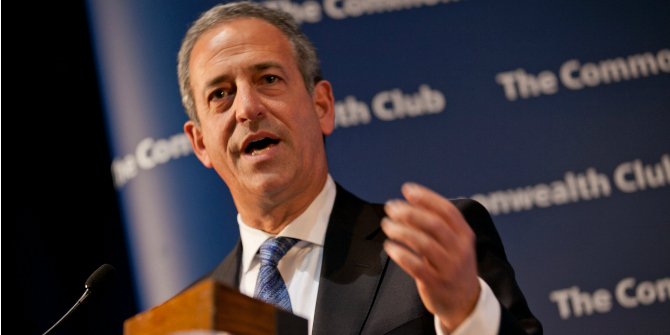 Wisconsin has voted for the Democratic presidential candidate for the past seven elections, and yet since 2010, the state has seen a notable swing towards the Republican Party in statewide and legislative races. As part of our series covering key Senate races in the 2016 election, Wendy Scattergood writes that former Senator Russ Feingold has a good chance of winning his old job back from incumbent Republican Senator, Ron Johnson, though this will also depend on turnout and on the top-ticket influence of Hillary Clinton.
Wisconsin has voted for the Democratic presidential candidate for the past seven elections, and yet since 2010, the state has seen a notable swing towards the Republican Party in statewide and legislative races. As part of our series covering key Senate races in the 2016 election, Wendy Scattergood writes that former Senator Russ Feingold has a good chance of winning his old job back from incumbent Republican Senator, Ron Johnson, though this will also depend on turnout and on the top-ticket influence of Hillary Clinton.
In a tight 2016 Senate race, where Democrats need to pick up a net four seats and the Vice Presidency to gain the majority and where there are few hotly contested races, Wisconsin is currently considered a potential pick-up for the Democrats. Incumbent Ron Johnson (R) is running against former Senator Russ Feingold (D) whom Johnson defeated in the Republican election wave of 2010. Phil Anderson is running as a Libertarian candidate. Earlier in the election season, given a comfortable Feingold lead, many outside groups (particularly pro-Johnson groups) pulled funding and ads out of the state. However, while polling still has Feingold up, the margin has been narrowing in October and both sides as well as outside groups have begun pouring money back into the state. At this point, polls and prognosticators still give Feingold a lead, but there are a number of factors we should examine in the final days before the election.
The Coattail Effect
In the last seven presidential elections, the Badger State has voted for a Democrat for president. Feingold himself was originally elected to office on the Clinton wave in 1992. The other Wisconsin Senator, Tammy Baldwin, was elected during Obama’s re-election bid in 2012. As of this writing, Clinton holds an average of 5.7 percent lead over Trump in Wisconsin, indicating that with the coattail effect, we would expect Feingold to retake the Senate seat.
Johnson was elected during the 2010 off-year election that swept Republicans into state legislative majorities in both houses, the governorship, and moved the partisan mix of House and Senate seats from the state to the right, so Wisconsin shows both presidential as well as off-year gubernatorial coattail effects and as the 2010 election showed, some serious backlash against the status quo. With the latest October Surprise aka the “Comey Effect” causing a narrowing of the presidential race, this could potentially cause an upset to the 28-year trend in Wisconsin of Democratic voting and senatorial coattail voting during presidential election years.

The Turnout Effect
The average turnout during off-year/gubernatorial elections since 1970 has been 46 percent compared to 67 percent for presidential elections. This helps Democrats during presidential years and it’s mixed for gubernatorial years, but since Scott Walker became Governor in 2010, off-year election turn-out seems to favor Republicans. Just based on turnout rates in presidential election years, again we would predict a Feingold win, but in this election that seems to be bucking all sorts of trends, if the GOP builds a ground game that gets out the vote, particularly in rural areas, and if Democrats experience an enthusiasm gap for Clinton that causes some to stay home, we could see a change with this effect.
The Down-Ballot Effect
There has been much discussion at the national level, particularly among Republicans, that Trump polling numbers showing him consistently behind does not bode well for other Republicans in Senate and House seats. There are two primary arguments here – one is that Republicans who either don’t like Trump and/or see the election as a lost cause may stay home and therefore won’t be voting for the other down-ballot Republican candidates. The other argument is about women, particularly college-educated women defecting from the Republican Party, which may lead to some of these women voting straight-ticket rather than crossing back over to the Republican Party for the down-ballot candidates.
The problem with these arguments however, is that one could make those same arguments about the Democrats, particularly given the latest “Comey Effect” on Clinton’s polling numbers. In addition, with college-aged women, using The Wisconsin Survey and comparing 2012 with 2016, in 2012, 56 percent of college-educated women in Wisconsin said they were going to vote for Obama while this year, 53 percent of college-educated women said they were going to vote for Clinton. Among all women, while the vote for the Democratic presidential nominee is the same 2012 to 2016, the women’s vote for the Republican presidential candidate is down by 5 percent. In looking at this discrepancy in more detail, there is a Clinton effect among Republican-leaning women (41 percent of them say they are going to vote for Clinton and 47 percent for Trump), but this is offset by more Democrat and Democrat-leaning women saying they aren’t sure for whom they will vote, or that they will vote for someone else.
In the Senate race, using the same 2016 Wisconsin Survey, Feingold had a 12 percent lead over Johnson compared to an 8 percent Clinton lead over Trump, though other polls had the Senate race closer. To figure out why Feingold has a bigger lead than Clinton in Wisconsin, I looked at the group of people who said they will vote for Feingold, but not for Clinton. There seems to be a “throw the rascals out” phenomenon. Though many of the ads run by Johnson have framed Feingold as the Washington insider, among this group of Feingold-but-not-Clinton voters, they are much more likely than the rest of those surveyed to say the economy is poor, that the nation is going in the wrong direction, they are more dissatisfied with all governmental leaders, less interested in the election than others polled, and just over half of them say they are going to vote for Trump. Clearly a Trump-Feingold vote is not about policy issues, but would seem rather to indicate a backlash against the status quo.
So, what does all this mean for the final days before the election? Based solely on past trends, where the polls are at this moment, and the newest Gallup poll that shows basically no change in Clinton’s favorability ratings pre-post announcement of the FBI investigation, one would have to predict a Feingold win. However, in this bizarre election, with its numerous twists, turns, and surprises, there are a number of ways this election could very well at least produce a hiccup in coattail, turn-out, and straight ticket down ballot trends that could alter Wisconsin election outcomes.
Featured image: Russ Feingold. Credit: JD Lasica (Flickr, CC-BY-NC-2.0)
Please read our comments policy before commenting.
Note: This article gives the views of the author, and not the position of USAPP– American Politics and Policy, nor of the London School of Economics.
Shortened URL for this post: http://bit.ly/2fgbCyu
______________________
 Wendy Scattergood – St. Norbert College
Wendy Scattergood – St. Norbert College
Wendy Scattergood is an assistant professor of Political Science and an associate with the Strategic Research Center at St. Norbert College in De Pere, Wisconsin. She teaches courses on American political polarization, global political extremism, environmental politics, and policy analysis. She has written and analyzed the bi-annual Wisconsin Survey for the last 15 years.






